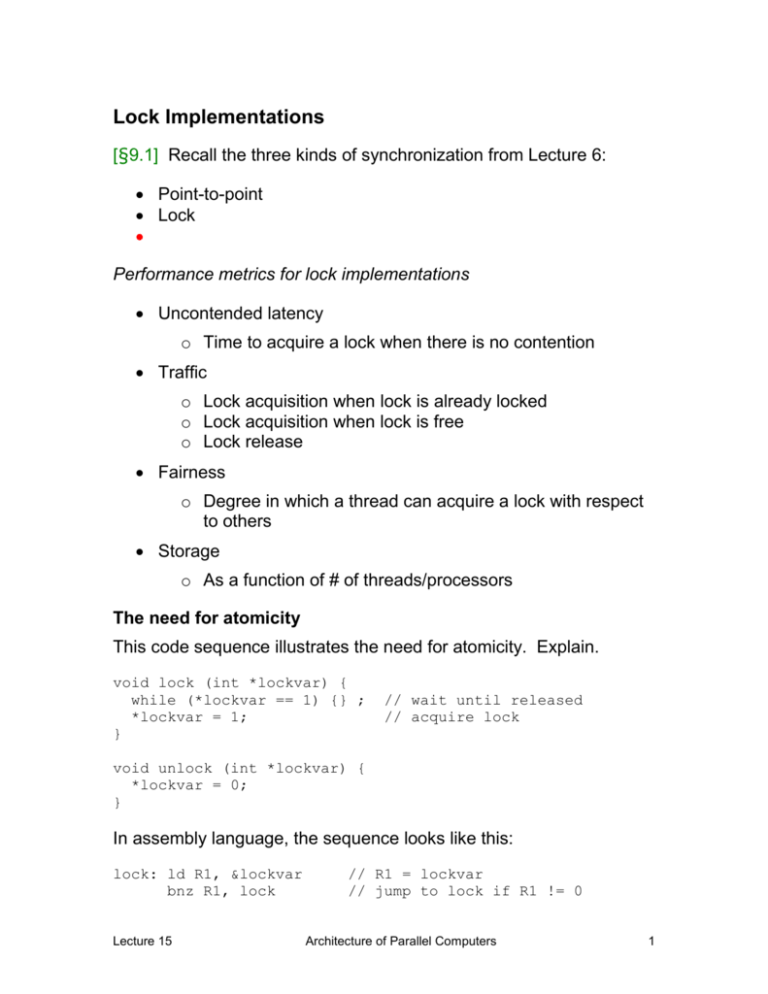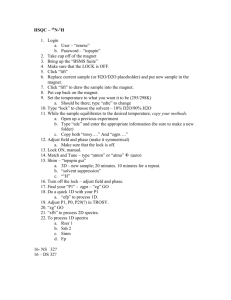DOC
advertisement

Lock Implementations
[§9.1] Recall the three kinds of synchronization from Lecture 6:
Point-to-point
Lock
Performance metrics for lock implementations
Uncontended latency
o Time to acquire a lock when there is no contention
Traffic
o Lock acquisition when lock is already locked
o Lock acquisition when lock is free
o Lock release
Fairness
o Degree in which a thread can acquire a lock with respect
to others
Storage
o As a function of # of threads/processors
The need for atomicity
This code sequence illustrates the need for atomicity. Explain.
void lock (int *lockvar) {
while (*lockvar == 1) {} ;
*lockvar = 1;
}
// wait until released
// acquire lock
void unlock (int *lockvar) {
*lockvar = 0;
}
In assembly language, the sequence looks like this:
lock: ld R1, &lockvar
bnz R1, lock
Lecture 15
// R1 = lockvar
// jump to lock if R1 != 0
Architecture of Parallel Computers
1
st &lockvar, #1
//
ret
//
unlock: sti &lockvar, #0 //
ret
//
lockvar =
return to
lockvar =
return to
1
caller
0
caller
The ld-to-sti sequence must be executed atomically:
The sequence appears to execute in its entirety
Multiple sequences are serialized
Examples of atomic instructions
test-and-set Rx, M
o read the value stored in memory location M, test the value
against a constant (e.g. 0), and if they match, write the
value in register Rx to the memory location M.
fetch-and-op M
o read the value stored in memory location M, perform op to
it (e.g., increment, decrement, addition, subtraction), then
store the new value to the memory location M.
exchange Rx, M
o atomically exchange (or swap) the value in memory
location M with the value in register Rx.
compare-and-swap Rx, Ry, M
o compare the value in memory location M with the value in
register Rx. If they match, write the value in register Ry to
M, and copy the value in Rx to Ry.
How to ensure one atomic instruction is executed at a time:
1. Reserve the bus until done
o Other atomic instructions cannot get to the bus
© 2012 Edward F. Gehringer
CSC/ECE 506 Lecture Notes, Spring 2012
2
2. Reserve the cache block involved until done
o Obtain exclusive permission (e.g. “M” in MESI)
o Reject or delay any invalidation or intervention requests
until done
3. Provide “illusion” of atomicity instead
o Using load-link/store-conditional (to be discussed later)
Test and set
test-and-set is implemented like this:
lock:
t&s R1, &lockvar
bnz R1, lock;
ret
unlock: st &lockvar, #0
ret
//
//
//
//
//
//
R1 = MEM[&lockvar];
if (R1==0) MEM[&lockvar]=1
jump to lock if R1 != 0
return to caller
MEM[&lockvar] = 0
return to caller
What value does lockvar have when the lock is acquired? free?
Here is an example of test-and-set execution. Describe what it
shows.
Let’s look at how a sequence of test-and-sets by three processors
plays out:
Lecture 15
Architecture of Parallel Computers
3
Request
P1
P2
P3
BusRequest
Initially
–
–
–
–
P1: t&s
M
–
–
BusRdX
P2: t&s
I
M
–
BusRdX
P3: t&s
I
I
M
BusRdX
P2: t&s
I
M
I
BusRdX
P1: unlock
M
I
I
BusRdX
P2: t&s
I
M
I
BusRdX
P3: t&s
I
I
M
BusRdX
P3: t&s
I
I
M
–
P2: unlock
I
M
I
BusRdX
P3: t&s
I
I
M
BusRdX
P3: unlock
I
I
M
–
How does test-and-set perform on the four metrics listed above?
Uncontended latency
Fairness
Traffic
Storage
Drawbacks of Test&Set Lock (TSL)
What is the main drawback of test&set locks?
Without changing the lock mechanism, how can we diminish this
overhead?
: pause for awhile
© 2012 Edward F. Gehringer
CSC/ECE 506 Lecture Notes, Spring 2012
4
o
by too little:
o
by too much:
Exponential
: Increase the
exponentially with each failure.
interval
Test and Test&Set Lock (TTSL)
Busy-wait with ordinary read operations, not test&set.
o Cached lock variable will be invalidated when release
occurs
When value changes (to 0), try to obtain lock with test&set
o Only one attempter will succeed; others will fail and start
testing again.
Let’s compare the code for TSL with TTSL.
TSL:
lock:
t&s R1, &lockvar
bnz R1, lock;
ret
unlock: st &lockvar, #0
ret
//
//
//
//
//
//
R1 = MEM[&lockvar];
if (R1==0) MEM[&lockvar]=1
jump to lock if R1 != 0
return to caller
MEM[&lockvar] = 0
return to caller
TTSL:
lock:
ld R1, &lockvar // R1 = MEM[&lockvar]
bnz R1, lock;
// jump to lock if R1 != 0
t&s R1, &lockvar // R1 = MEM[&lockvar];
// if (R1==0)MEM[&lockvar]=1
bnz R1, lock;
// jump to lock if R1 != 0
ret
// return to caller
unlock: st &lockvar, #0 // MEM[&lockvar] = 0
ret
// return to caller
Lecture 15
Architecture of Parallel Computers
5
The lock method now contains two loops. What would happen if we
removed the second loop?
Here’s a trace of a TSL, and then TTSL, execution. Let’s compare
them line by line.
Fill out this table:
TSL
TTSL
# BusReads
# BusReadXs
# BusUpgrs
# invalidations
(What’s the proper way to count invalidations?)
© 2012 Edward F. Gehringer
CSC/ECE 506 Lecture Notes, Spring 2012
6
TSL: Request
Initially
P1: t&s
P2: t&s
P3: t&s
P2: t&s
P1: unlock
P2: t&s
P3: t&s
P3: t&s
P2: unlock
P3: t&s
P3: unlock
P1
–
M
I
I
I
M
I
I
I
I
I
I
P2
–
–
M
I
M
I
M
I
I
M
I
I
P3
–
–
–
M
I
I
I
M
M
I
M
M
BusRequest
–
BusRdX
BusRdX
BusRdX
BusRdX
BusRdX
BusRdX
BusRdX
–
BusRdX
BusRdX
–
TTSL: Request
P1
P2
P3
Bus Request
Initially
P1: ld
P1: t&s
P2: ld
P3: ld
P2: ld
P1: unlock
P2: ld
P2: t&s
P3: ld
P3: ld
P2: unlock
P3: ld
P3: t&s
P3: unlock
–
E
M
S
S
S
M
S
I
I
I
I
I
I
I
–
–
–
S
S
S
I
S
M
S
S
M
S
I
I
–
–
–
S
S
I
I
I
S
S
I
S
M
M
–
BusRd
–
BusRd
BusRd
–
BusUpgr
BusRd
BusUpgr
BusRd
–
BusUpgr
BusRd
BusUpgr
–
Lecture 15
Architecture of Parallel Computers
7
TSL vs. TTSL summary
Successful lock acquisition:
o 2 bus transactions in TTSL
1 BusRd to intervene with a remotely cached block
1 BusUpgr to invalidate all remote copies
o vs. only 1 in TSL
1 BusRdX to invalidate all remote copies
Failed lock acquisition:
o 1 bus transaction in TTSL
1 BusRd to read a copy
then, loop until lock becomes free
o vs. unlimited with TSL
Each attempt generates a BusRdX
LL/SC
TTSL is an improvement over TSL.
But bus-based locking
o has a limited applicability (explain)
o is not scalable with fine-grain locks (explain)
Suppose we could lock a cache block instead of a bus …
o Expensive, must rely on buffering or NACK
Instead of providing atomicity, can we provide an illusion of
atomicity instead?
o This would involve detecting a violation of atomicity.
o If something “happens to” the value loaded, cancel the
store (because we must not allow newly stored value to
become visible to other processors)
© 2012 Edward F. Gehringer
CSC/ECE 506 Lecture Notes, Spring 2012
8
o Go back and repeat all other instructions (load, branch,
etc.).
This can be done with two new instructions:
Load Linked/Locked (LL)
o reads a word from memory, and
o stores the address in a special LL register
o The LL register is cleared if anything happens that may
break atomicity, e.g.,
A context switch occurs
The block containing the address in LL register is
invalidated.
Store Conditional (SC)
o tests whether the address in the LL register matches the
store address
o if so, store succeeds: store goes to cache/memory;
o else, store fails: the store is canceled, 0 is returned.
Here is the code.
lock: LL R1, &lockvar //
//
bnz R1, lock
//
add R1, R1, #1 //
SC R1, &lockvar //
beqz R1, lock
//
ret
//
R1 = lockvar;
LINKREG = &lockvar
jump to lock if R1 != 0
R1 = 1
lockvar = R1;
jump to lock if SC fails
return to caller
unlock: st &lockvar, #0 // lockvar = 0
ret
// return to caller
Note that this code, like the TTSL code, consists of two loops.
Compare each loop with its TTSL counterpart.
The first loop
The second loop
Lecture 15
Architecture of Parallel Computers
9
Here is a trace of execution. Compare it with TTSL.
Request
Initially
P1: LL
P1: SC
P2: LL
P3: LL
P2: LL
P1: unlock
P2: LL
P2: SC
P3: LL
P3: LL
P2: unlock
P3: LL
P3: SC
P3: unlock
P1
–
E
M
S
S
S
M
S
I
I
I
I
I
I
I
P2
–
–
–
S
S
S
I
S
M
S
S
M
S
I
I
P3
–
–
–
–
S
S
I
I
I
S
S
I
S
M
M
BusRequest
–
BusRd
–
BusRd
BusRd
–
BusUpgr
BusRd
BusUpgr
BusRd
–
BusUpgr
BusRd
BusUpgr
–
Similar bus traffic
o Spinning using loads no bus transactions when the
lock is not free
o Successful lock acquisition involves two bus transactions.
What are they?
But a failed SC does not generate a bus transaction (in TTSL,
all test&sets generate bus transactions).
o Why don’t SCs fail often?
Limitations of LL/SC
Suppose a lock is highly contended by p threads
© 2012 Edward F. Gehringer
CSC/ECE 506 Lecture Notes, Spring 2012
10
o There are O(p) attempts to acquire and release a lock
o A single release invalidates O(p) caches, causing O(p)
subsequent cache misses
o Hence, each critical section causes O(p2) bus traffic
Fairness: There is no guarantee that a thread that contends for
a lock will eventually acquire it.
These issues can be addressed by two different kinds of locks.
Ticket Lock
Ensures fairness, but still incurs O(p2) traffic
Uses the concept of a “bakery” queue
A thread attempting to acquire a lock is given a ticket number
representing its position in the queue.
Lock acquisition order follows the queue order.
Implementation:
ticketLock_init(int *next_ticket, int *now_serving) {
*now_serving = *next_ticket = 0;
}
ticketLock_acquire(int *next_ticket, int *now_serving) {
my_ticket = fetch_and_inc(next_ticket);
while (*now_serving != my_ticket) {};
}
ticketLock_release(int *next_ticket, int *now_serving) {
*now_serving++;
}
Trace:
Lecture 15
Architecture of Parallel Computers
11
Steps
next_ticket now_serving
my_ticket
Initially
P1: fetch&inc
P2: fetch&inc
P3: fetch&inc
P1:now_serving++
P2:now_serving++
0
1
2
3
3
3
0
0
0
0
1
2
P1
–
0
0
0
0
0
P3:now_serving++
3
3
0
P2 P3
– –
– –
1 –
1 2
1 2
1 2
1
2
Note that fetch&inc can be implemented with LL/SC.
Array-Based Queueing Locks
With a ticket lock, a release still invalidates O(p) caches.
Idea: Avoid this by letting each thread wait for a unique variable.
Waiting processes poll on different locations in an array of size p.
Just change now_serving to an array! (renamed “can_serve”).
A thread attempting to acquire a lock is given a ticket number in the
queue.
Lock acquisition order follows the queue order
Acquire
o fetch&inc obtains the address on which to spin (the next
array element).
o We must ensure that these addresses are in different
cache lines or memories
Release
o Set next location in array to 1, thus waking up process
spinning on it.
Advantages and disadvantages:
O(1) traffic per acquire with coherent caches
o And each release invalidates only one cache.
© 2012 Edward F. Gehringer
CSC/ECE 506 Lecture Notes, Spring 2012
12
FIFO ordering, as in ticket lock, ensuring fairness
But, O(p) space per lock
Good scalability for bus-based machines
Implementation:
ABQL_init(int *next_ticket, int *can_serve) {
*next_ticket = 0;
for (i=1; i<MAXSIZE; i++)
can_serve[i] = 0;
can_serve[0] = 1;
}
ABQL_acquire(int *next_ticket, int *can_serve) {
*my_ticket = fetch_and_inc(next_ticket);
while (can_serve[*my_ticket] != 1) {};
}
ABQL_release(int *next_ticket, int *can_serve) {
can_serve[*my_ticket + 1] = 1;
can_serve[*my_ticket] = 0; // prepare for next time
}
Trace:
Steps
Initially
P1: f&i
P2: f&i
P3: f&i
P1: can_serve[1]=1
P2: can_serve[2]=1
P3: can_serve[3]=1
next_ticket can_serve[]
0
1
2
3
3
3
3
[1, 0, 0, 0]
[1, 0, 0, 0]
[1, 0, 0, 0]
[1, 0, 0, 0]
[0, 1, 0, 0]
[0, 0, 1, 0]
[0, 0, 0, 1]
my_ticket
P1 P2 P3
– – –
0 – –
0 1 –
0 1 2
0 1 2
0 1 2
0 1 2
Let’s compare array-based queueing locks with ticket locks.
Fill out this table, assuming that 10 threads are competing:
Lecture 15
Architecture of Parallel Computers
13
Ticket locks
Array-based
queueing locks
#of invalidations
# of subsequent
cache misses
Comparison of lock implementations
Criterion
Uncontested latency
TSL
TTSL LL/SC Ticket
ABQL
Lowest Lower Lower Higher
Higher
1 release max traffic
O(p)
O(p)
O(p)
O(p)
O(1)
Wait traffic
High
–
–
–
–
Storage
O(1)
O(1)
O(1)
O(1)
O(p)
No
No
No
Yes
Yes
Fairness guaranteed?
Discussion:
Design must balance latency vs. scalability
o ABQL is not necessarily best.
o Often LL/SC locks perform very well.
o Scalable programs rarely use highly-contended locks.
Fairness sounds good in theory, but
o Must ensure that the current/next lock holder does not
suffer from context switches or any long delay events
© 2012 Edward F. Gehringer
CSC/ECE 506 Lecture Notes, Spring 2012
14








